Australian Tyre Retailer: Consumer Purchase Decision Analysis
VerifiedAdded on 2023/06/04
|15
|3011
|374
Report
AI Summary
This report presents a case study focusing on an Australian tyre retailer experiencing declining market share despite selling well-known brands. The new CEO's observations revealed issues with the physical layout of the stores, particularly high counters and a lack of comfortable seating, which negatively impacted female customers. The research aims to identify factors driving customers to visit physical stores, understand women's requirements, and determine the benefits of improving the store's physical appearance. The report utilizes a descriptive research design with primary data collected through online surveys targeting 100 female customers, and employs quantitative data analysis techniques to identify key issues and provide recommendations for improving customer experience and increasing market share. Desklib provides a platform for students to access similar case studies and solved assignments.
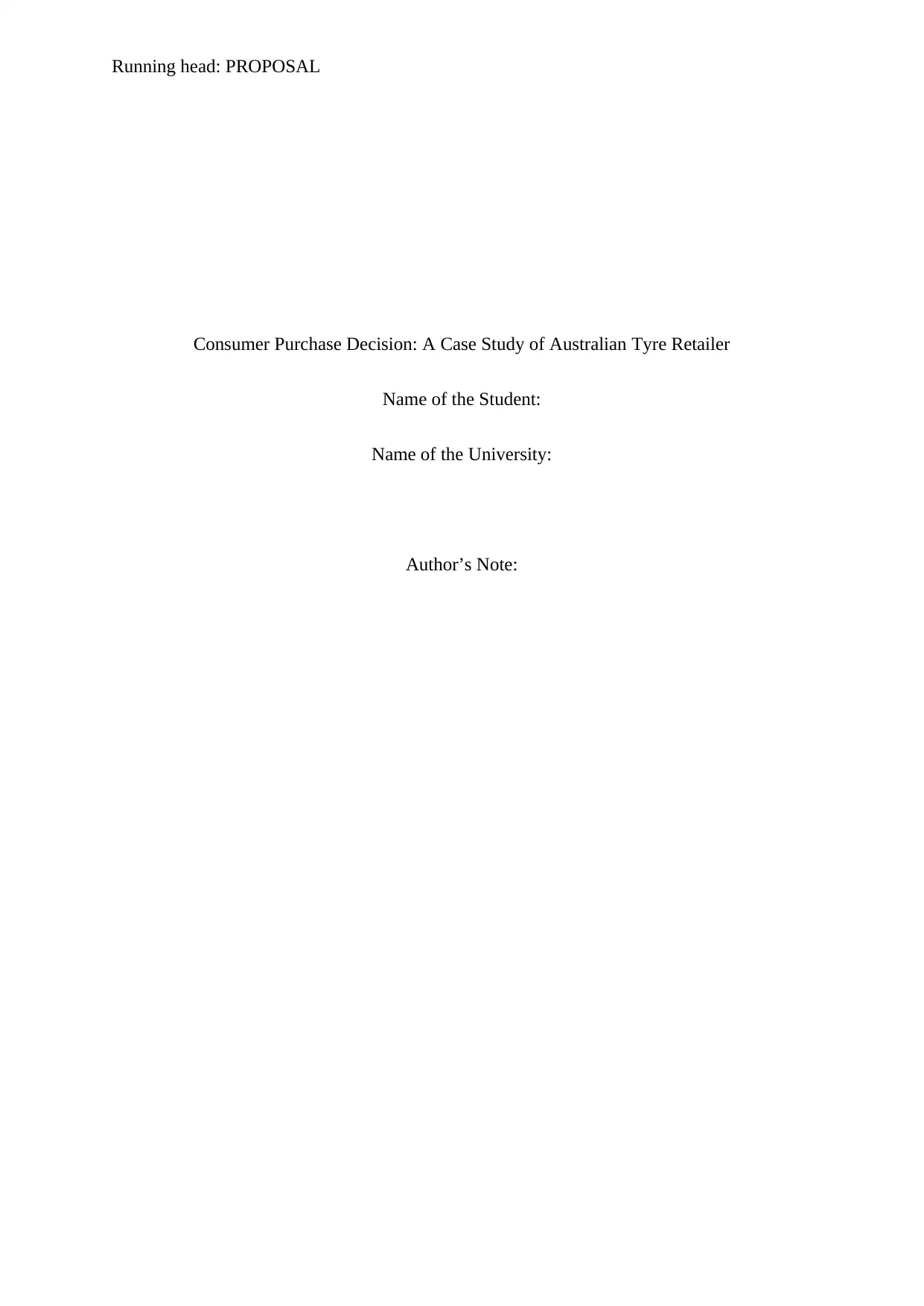
Running head: PROPOSAL
Consumer Purchase Decision: A Case Study of Australian Tyre Retailer
Name of the Student:
Name of the University:
Author’s Note:
Consumer Purchase Decision: A Case Study of Australian Tyre Retailer
Name of the Student:
Name of the University:
Author’s Note:
Paraphrase This Document
Need a fresh take? Get an instant paraphrase of this document with our AI Paraphraser
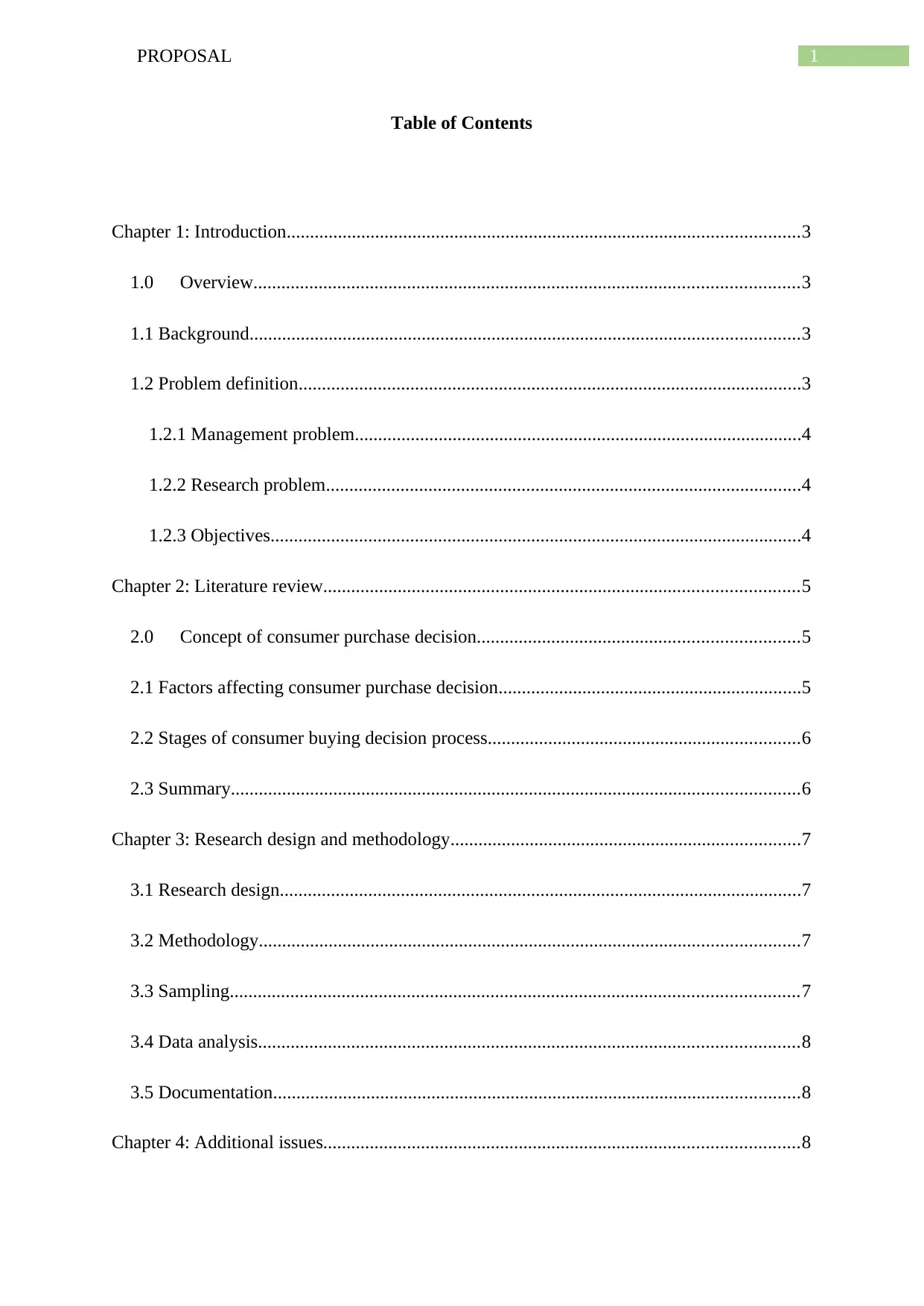
1PROPOSAL
Table of Contents
Chapter 1: Introduction..............................................................................................................3
1.0 Overview.....................................................................................................................3
1.1 Background......................................................................................................................3
1.2 Problem definition............................................................................................................3
1.2.1 Management problem................................................................................................4
1.2.2 Research problem......................................................................................................4
1.2.3 Objectives..................................................................................................................4
Chapter 2: Literature review......................................................................................................5
2.0 Concept of consumer purchase decision.....................................................................5
2.1 Factors affecting consumer purchase decision.................................................................5
2.2 Stages of consumer buying decision process...................................................................6
2.3 Summary..........................................................................................................................6
Chapter 3: Research design and methodology...........................................................................7
3.1 Research design................................................................................................................7
3.2 Methodology....................................................................................................................7
3.3 Sampling..........................................................................................................................7
3.4 Data analysis....................................................................................................................8
3.5 Documentation.................................................................................................................8
Chapter 4: Additional issues......................................................................................................8
Table of Contents
Chapter 1: Introduction..............................................................................................................3
1.0 Overview.....................................................................................................................3
1.1 Background......................................................................................................................3
1.2 Problem definition............................................................................................................3
1.2.1 Management problem................................................................................................4
1.2.2 Research problem......................................................................................................4
1.2.3 Objectives..................................................................................................................4
Chapter 2: Literature review......................................................................................................5
2.0 Concept of consumer purchase decision.....................................................................5
2.1 Factors affecting consumer purchase decision.................................................................5
2.2 Stages of consumer buying decision process...................................................................6
2.3 Summary..........................................................................................................................6
Chapter 3: Research design and methodology...........................................................................7
3.1 Research design................................................................................................................7
3.2 Methodology....................................................................................................................7
3.3 Sampling..........................................................................................................................7
3.4 Data analysis....................................................................................................................8
3.5 Documentation.................................................................................................................8
Chapter 4: Additional issues......................................................................................................8

2PROPOSAL
4.1 Limitations.......................................................................................................................8
4.2 Budget..............................................................................................................................9
4.3 Timeline...........................................................................................................................9
4.4 Ethical consideration......................................................................................................10
References................................................................................................................................12
4.1 Limitations.......................................................................................................................8
4.2 Budget..............................................................................................................................9
4.3 Timeline...........................................................................................................................9
4.4 Ethical consideration......................................................................................................10
References................................................................................................................................12
⊘ This is a preview!⊘
Do you want full access?
Subscribe today to unlock all pages.

Trusted by 1+ million students worldwide
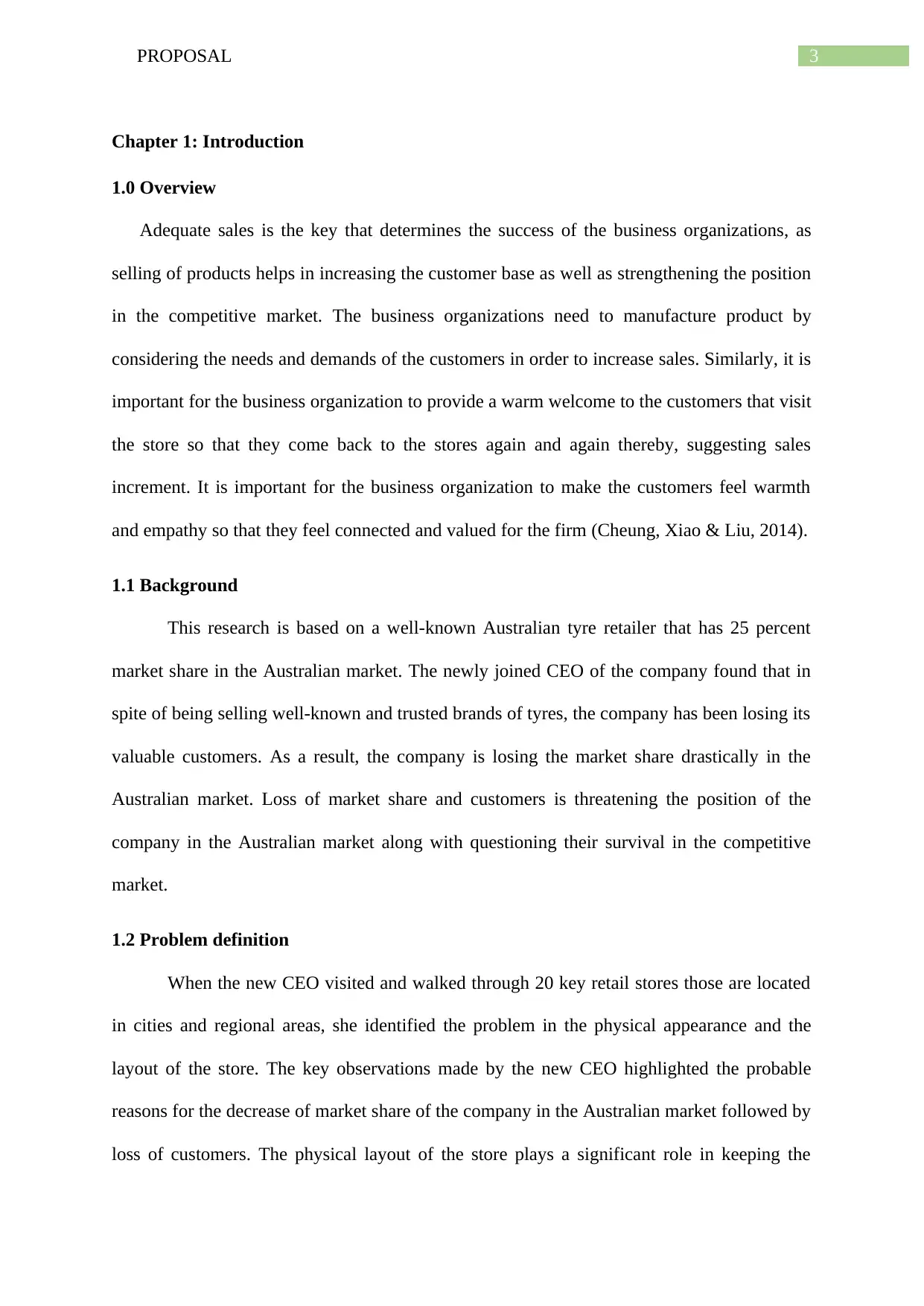
3PROPOSAL
Chapter 1: Introduction
1.0 Overview
Adequate sales is the key that determines the success of the business organizations, as
selling of products helps in increasing the customer base as well as strengthening the position
in the competitive market. The business organizations need to manufacture product by
considering the needs and demands of the customers in order to increase sales. Similarly, it is
important for the business organization to provide a warm welcome to the customers that visit
the store so that they come back to the stores again and again thereby, suggesting sales
increment. It is important for the business organization to make the customers feel warmth
and empathy so that they feel connected and valued for the firm (Cheung, Xiao & Liu, 2014).
1.1 Background
This research is based on a well-known Australian tyre retailer that has 25 percent
market share in the Australian market. The newly joined CEO of the company found that in
spite of being selling well-known and trusted brands of tyres, the company has been losing its
valuable customers. As a result, the company is losing the market share drastically in the
Australian market. Loss of market share and customers is threatening the position of the
company in the Australian market along with questioning their survival in the competitive
market.
1.2 Problem definition
When the new CEO visited and walked through 20 key retail stores those are located
in cities and regional areas, she identified the problem in the physical appearance and the
layout of the store. The key observations made by the new CEO highlighted the probable
reasons for the decrease of market share of the company in the Australian market followed by
loss of customers. The physical layout of the store plays a significant role in keeping the
Chapter 1: Introduction
1.0 Overview
Adequate sales is the key that determines the success of the business organizations, as
selling of products helps in increasing the customer base as well as strengthening the position
in the competitive market. The business organizations need to manufacture product by
considering the needs and demands of the customers in order to increase sales. Similarly, it is
important for the business organization to provide a warm welcome to the customers that visit
the store so that they come back to the stores again and again thereby, suggesting sales
increment. It is important for the business organization to make the customers feel warmth
and empathy so that they feel connected and valued for the firm (Cheung, Xiao & Liu, 2014).
1.1 Background
This research is based on a well-known Australian tyre retailer that has 25 percent
market share in the Australian market. The newly joined CEO of the company found that in
spite of being selling well-known and trusted brands of tyres, the company has been losing its
valuable customers. As a result, the company is losing the market share drastically in the
Australian market. Loss of market share and customers is threatening the position of the
company in the Australian market along with questioning their survival in the competitive
market.
1.2 Problem definition
When the new CEO visited and walked through 20 key retail stores those are located
in cities and regional areas, she identified the problem in the physical appearance and the
layout of the store. The key observations made by the new CEO highlighted the probable
reasons for the decrease of market share of the company in the Australian market followed by
loss of customers. The physical layout of the store plays a significant role in keeping the
Paraphrase This Document
Need a fresh take? Get an instant paraphrase of this document with our AI Paraphraser

4PROPOSAL
customers busy and engaged. For this Australian tyre retailer, the main problem identified is
the presence of high counters due to which the store managers are hid behind them thereby,
making communication difficult for everyone expect the ones with tall height. As majority of
the cash customers of the company were women, communicating is often an issue for them.
In addition to, the store required the customers to stand and lacked appropriate sitting
arrangements and the stacks were filled with truck and car magazines.
1.2.1 Management problem
The problem for the management include:
How would Australian tyre retailer improve customer experience when they visit the
retail stores physically?
How should the Australian tyre retailer increase the market share in the Australian
market?
1.2.2 Research problem
The problem for the research is:
Which factors drive the customers in the Australian market to visit a store physically
for purchasing products?
1.2.3 Objectives
The objectives of the research are:
To determine the trends regarding the opinion of the women customers for visiting a
store physically
Understand the requirement of the women customers when they visit a store
Sort the determined benefits of improving the overall physical appearance of the retail
stores
customers busy and engaged. For this Australian tyre retailer, the main problem identified is
the presence of high counters due to which the store managers are hid behind them thereby,
making communication difficult for everyone expect the ones with tall height. As majority of
the cash customers of the company were women, communicating is often an issue for them.
In addition to, the store required the customers to stand and lacked appropriate sitting
arrangements and the stacks were filled with truck and car magazines.
1.2.1 Management problem
The problem for the management include:
How would Australian tyre retailer improve customer experience when they visit the
retail stores physically?
How should the Australian tyre retailer increase the market share in the Australian
market?
1.2.2 Research problem
The problem for the research is:
Which factors drive the customers in the Australian market to visit a store physically
for purchasing products?
1.2.3 Objectives
The objectives of the research are:
To determine the trends regarding the opinion of the women customers for visiting a
store physically
Understand the requirement of the women customers when they visit a store
Sort the determined benefits of improving the overall physical appearance of the retail
stores
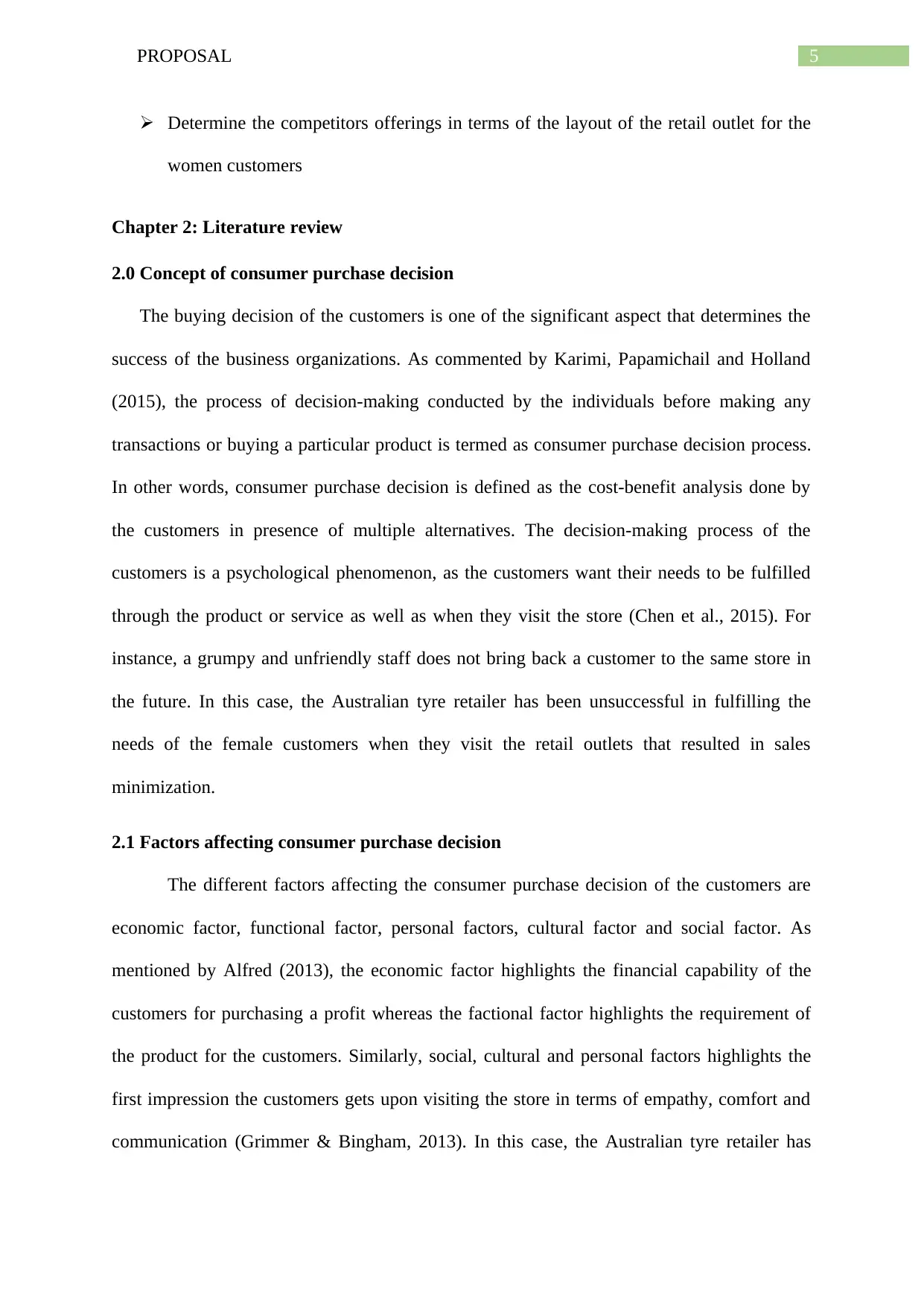
5PROPOSAL
Determine the competitors offerings in terms of the layout of the retail outlet for the
women customers
Chapter 2: Literature review
2.0 Concept of consumer purchase decision
The buying decision of the customers is one of the significant aspect that determines the
success of the business organizations. As commented by Karimi, Papamichail and Holland
(2015), the process of decision-making conducted by the individuals before making any
transactions or buying a particular product is termed as consumer purchase decision process.
In other words, consumer purchase decision is defined as the cost-benefit analysis done by
the customers in presence of multiple alternatives. The decision-making process of the
customers is a psychological phenomenon, as the customers want their needs to be fulfilled
through the product or service as well as when they visit the store (Chen et al., 2015). For
instance, a grumpy and unfriendly staff does not bring back a customer to the same store in
the future. In this case, the Australian tyre retailer has been unsuccessful in fulfilling the
needs of the female customers when they visit the retail outlets that resulted in sales
minimization.
2.1 Factors affecting consumer purchase decision
The different factors affecting the consumer purchase decision of the customers are
economic factor, functional factor, personal factors, cultural factor and social factor. As
mentioned by Alfred (2013), the economic factor highlights the financial capability of the
customers for purchasing a profit whereas the factional factor highlights the requirement of
the product for the customers. Similarly, social, cultural and personal factors highlights the
first impression the customers gets upon visiting the store in terms of empathy, comfort and
communication (Grimmer & Bingham, 2013). In this case, the Australian tyre retailer has
Determine the competitors offerings in terms of the layout of the retail outlet for the
women customers
Chapter 2: Literature review
2.0 Concept of consumer purchase decision
The buying decision of the customers is one of the significant aspect that determines the
success of the business organizations. As commented by Karimi, Papamichail and Holland
(2015), the process of decision-making conducted by the individuals before making any
transactions or buying a particular product is termed as consumer purchase decision process.
In other words, consumer purchase decision is defined as the cost-benefit analysis done by
the customers in presence of multiple alternatives. The decision-making process of the
customers is a psychological phenomenon, as the customers want their needs to be fulfilled
through the product or service as well as when they visit the store (Chen et al., 2015). For
instance, a grumpy and unfriendly staff does not bring back a customer to the same store in
the future. In this case, the Australian tyre retailer has been unsuccessful in fulfilling the
needs of the female customers when they visit the retail outlets that resulted in sales
minimization.
2.1 Factors affecting consumer purchase decision
The different factors affecting the consumer purchase decision of the customers are
economic factor, functional factor, personal factors, cultural factor and social factor. As
mentioned by Alfred (2013), the economic factor highlights the financial capability of the
customers for purchasing a profit whereas the factional factor highlights the requirement of
the product for the customers. Similarly, social, cultural and personal factors highlights the
first impression the customers gets upon visiting the store in terms of empathy, comfort and
communication (Grimmer & Bingham, 2013). In this case, the Australian tyre retailer has
⊘ This is a preview!⊘
Do you want full access?
Subscribe today to unlock all pages.

Trusted by 1+ million students worldwide
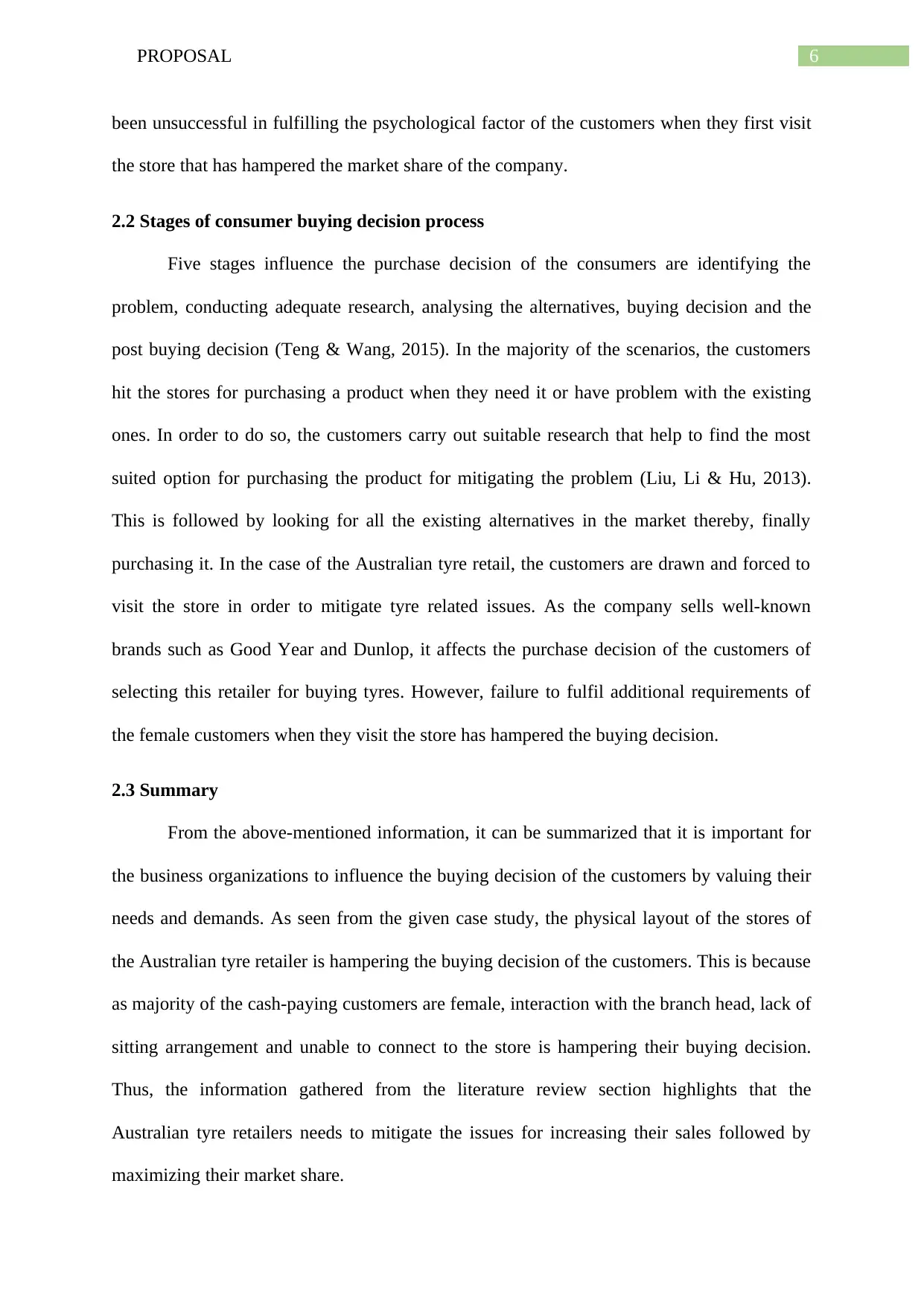
6PROPOSAL
been unsuccessful in fulfilling the psychological factor of the customers when they first visit
the store that has hampered the market share of the company.
2.2 Stages of consumer buying decision process
Five stages influence the purchase decision of the consumers are identifying the
problem, conducting adequate research, analysing the alternatives, buying decision and the
post buying decision (Teng & Wang, 2015). In the majority of the scenarios, the customers
hit the stores for purchasing a product when they need it or have problem with the existing
ones. In order to do so, the customers carry out suitable research that help to find the most
suited option for purchasing the product for mitigating the problem (Liu, Li & Hu, 2013).
This is followed by looking for all the existing alternatives in the market thereby, finally
purchasing it. In the case of the Australian tyre retail, the customers are drawn and forced to
visit the store in order to mitigate tyre related issues. As the company sells well-known
brands such as Good Year and Dunlop, it affects the purchase decision of the customers of
selecting this retailer for buying tyres. However, failure to fulfil additional requirements of
the female customers when they visit the store has hampered the buying decision.
2.3 Summary
From the above-mentioned information, it can be summarized that it is important for
the business organizations to influence the buying decision of the customers by valuing their
needs and demands. As seen from the given case study, the physical layout of the stores of
the Australian tyre retailer is hampering the buying decision of the customers. This is because
as majority of the cash-paying customers are female, interaction with the branch head, lack of
sitting arrangement and unable to connect to the store is hampering their buying decision.
Thus, the information gathered from the literature review section highlights that the
Australian tyre retailers needs to mitigate the issues for increasing their sales followed by
maximizing their market share.
been unsuccessful in fulfilling the psychological factor of the customers when they first visit
the store that has hampered the market share of the company.
2.2 Stages of consumer buying decision process
Five stages influence the purchase decision of the consumers are identifying the
problem, conducting adequate research, analysing the alternatives, buying decision and the
post buying decision (Teng & Wang, 2015). In the majority of the scenarios, the customers
hit the stores for purchasing a product when they need it or have problem with the existing
ones. In order to do so, the customers carry out suitable research that help to find the most
suited option for purchasing the product for mitigating the problem (Liu, Li & Hu, 2013).
This is followed by looking for all the existing alternatives in the market thereby, finally
purchasing it. In the case of the Australian tyre retail, the customers are drawn and forced to
visit the store in order to mitigate tyre related issues. As the company sells well-known
brands such as Good Year and Dunlop, it affects the purchase decision of the customers of
selecting this retailer for buying tyres. However, failure to fulfil additional requirements of
the female customers when they visit the store has hampered the buying decision.
2.3 Summary
From the above-mentioned information, it can be summarized that it is important for
the business organizations to influence the buying decision of the customers by valuing their
needs and demands. As seen from the given case study, the physical layout of the stores of
the Australian tyre retailer is hampering the buying decision of the customers. This is because
as majority of the cash-paying customers are female, interaction with the branch head, lack of
sitting arrangement and unable to connect to the store is hampering their buying decision.
Thus, the information gathered from the literature review section highlights that the
Australian tyre retailers needs to mitigate the issues for increasing their sales followed by
maximizing their market share.
Paraphrase This Document
Need a fresh take? Get an instant paraphrase of this document with our AI Paraphraser

7PROPOSAL
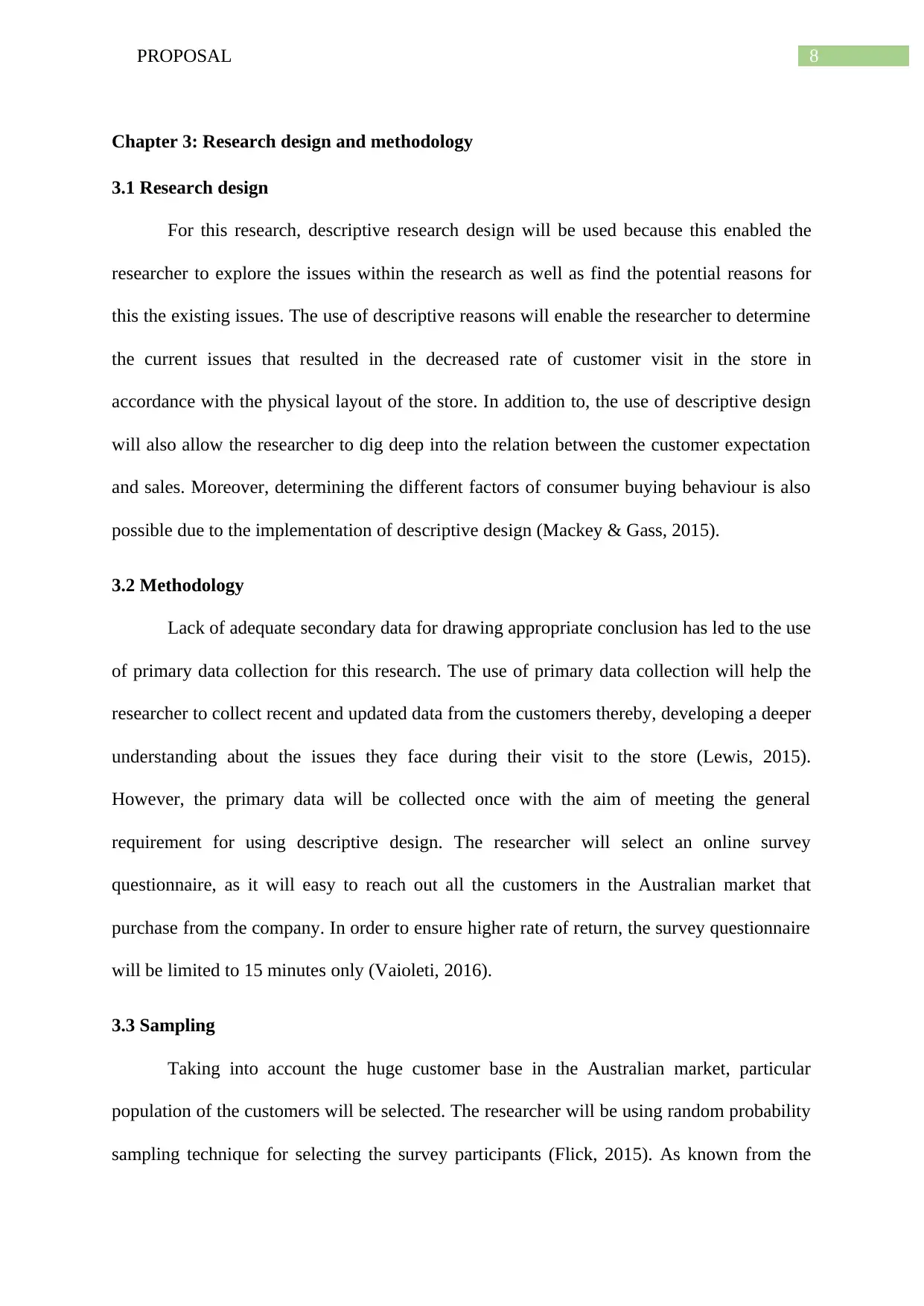
8PROPOSAL
Chapter 3: Research design and methodology
3.1 Research design
For this research, descriptive research design will be used because this enabled the
researcher to explore the issues within the research as well as find the potential reasons for
this the existing issues. The use of descriptive reasons will enable the researcher to determine
the current issues that resulted in the decreased rate of customer visit in the store in
accordance with the physical layout of the store. In addition to, the use of descriptive design
will also allow the researcher to dig deep into the relation between the customer expectation
and sales. Moreover, determining the different factors of consumer buying behaviour is also
possible due to the implementation of descriptive design (Mackey & Gass, 2015).
3.2 Methodology
Lack of adequate secondary data for drawing appropriate conclusion has led to the use
of primary data collection for this research. The use of primary data collection will help the
researcher to collect recent and updated data from the customers thereby, developing a deeper
understanding about the issues they face during their visit to the store (Lewis, 2015).
However, the primary data will be collected once with the aim of meeting the general
requirement for using descriptive design. The researcher will select an online survey
questionnaire, as it will easy to reach out all the customers in the Australian market that
purchase from the company. In order to ensure higher rate of return, the survey questionnaire
will be limited to 15 minutes only (Vaioleti, 2016).
3.3 Sampling
Taking into account the huge customer base in the Australian market, particular
population of the customers will be selected. The researcher will be using random probability
sampling technique for selecting the survey participants (Flick, 2015). As known from the
Chapter 3: Research design and methodology
3.1 Research design
For this research, descriptive research design will be used because this enabled the
researcher to explore the issues within the research as well as find the potential reasons for
this the existing issues. The use of descriptive reasons will enable the researcher to determine
the current issues that resulted in the decreased rate of customer visit in the store in
accordance with the physical layout of the store. In addition to, the use of descriptive design
will also allow the researcher to dig deep into the relation between the customer expectation
and sales. Moreover, determining the different factors of consumer buying behaviour is also
possible due to the implementation of descriptive design (Mackey & Gass, 2015).
3.2 Methodology
Lack of adequate secondary data for drawing appropriate conclusion has led to the use
of primary data collection for this research. The use of primary data collection will help the
researcher to collect recent and updated data from the customers thereby, developing a deeper
understanding about the issues they face during their visit to the store (Lewis, 2015).
However, the primary data will be collected once with the aim of meeting the general
requirement for using descriptive design. The researcher will select an online survey
questionnaire, as it will easy to reach out all the customers in the Australian market that
purchase from the company. In order to ensure higher rate of return, the survey questionnaire
will be limited to 15 minutes only (Vaioleti, 2016).
3.3 Sampling
Taking into account the huge customer base in the Australian market, particular
population of the customers will be selected. The researcher will be using random probability
sampling technique for selecting the survey participants (Flick, 2015). As known from the
⊘ This is a preview!⊘
Do you want full access?
Subscribe today to unlock all pages.

Trusted by 1+ million students worldwide
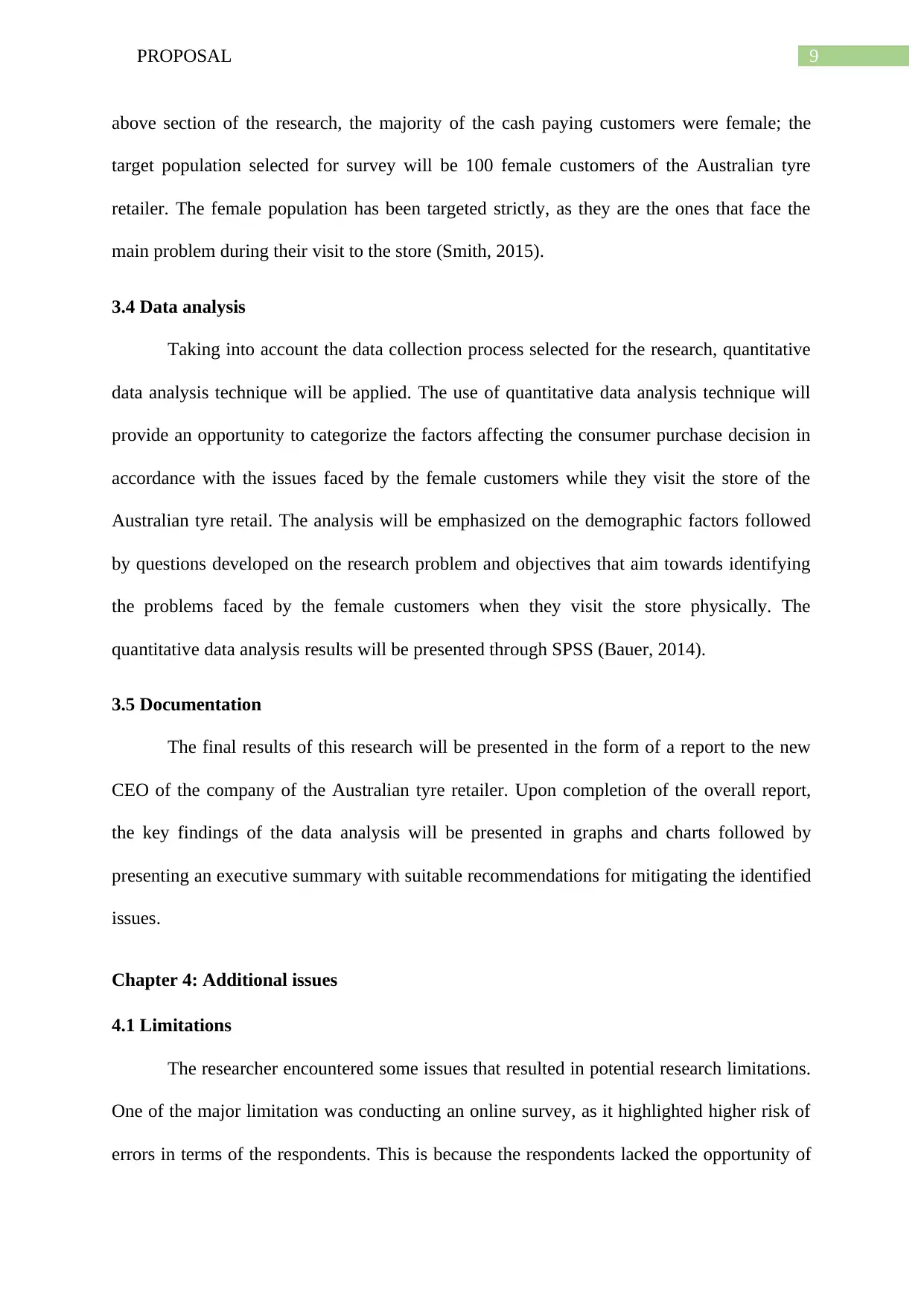
9PROPOSAL
above section of the research, the majority of the cash paying customers were female; the
target population selected for survey will be 100 female customers of the Australian tyre
retailer. The female population has been targeted strictly, as they are the ones that face the
main problem during their visit to the store (Smith, 2015).
3.4 Data analysis
Taking into account the data collection process selected for the research, quantitative
data analysis technique will be applied. The use of quantitative data analysis technique will
provide an opportunity to categorize the factors affecting the consumer purchase decision in
accordance with the issues faced by the female customers while they visit the store of the
Australian tyre retail. The analysis will be emphasized on the demographic factors followed
by questions developed on the research problem and objectives that aim towards identifying
the problems faced by the female customers when they visit the store physically. The
quantitative data analysis results will be presented through SPSS (Bauer, 2014).
3.5 Documentation
The final results of this research will be presented in the form of a report to the new
CEO of the company of the Australian tyre retailer. Upon completion of the overall report,
the key findings of the data analysis will be presented in graphs and charts followed by
presenting an executive summary with suitable recommendations for mitigating the identified
issues.
Chapter 4: Additional issues
4.1 Limitations
The researcher encountered some issues that resulted in potential research limitations.
One of the major limitation was conducting an online survey, as it highlighted higher risk of
errors in terms of the respondents. This is because the respondents lacked the opportunity of
above section of the research, the majority of the cash paying customers were female; the
target population selected for survey will be 100 female customers of the Australian tyre
retailer. The female population has been targeted strictly, as they are the ones that face the
main problem during their visit to the store (Smith, 2015).
3.4 Data analysis
Taking into account the data collection process selected for the research, quantitative
data analysis technique will be applied. The use of quantitative data analysis technique will
provide an opportunity to categorize the factors affecting the consumer purchase decision in
accordance with the issues faced by the female customers while they visit the store of the
Australian tyre retail. The analysis will be emphasized on the demographic factors followed
by questions developed on the research problem and objectives that aim towards identifying
the problems faced by the female customers when they visit the store physically. The
quantitative data analysis results will be presented through SPSS (Bauer, 2014).
3.5 Documentation
The final results of this research will be presented in the form of a report to the new
CEO of the company of the Australian tyre retailer. Upon completion of the overall report,
the key findings of the data analysis will be presented in graphs and charts followed by
presenting an executive summary with suitable recommendations for mitigating the identified
issues.
Chapter 4: Additional issues
4.1 Limitations
The researcher encountered some issues that resulted in potential research limitations.
One of the major limitation was conducting an online survey, as it highlighted higher risk of
errors in terms of the respondents. This is because the respondents lacked the opportunity of
Paraphrase This Document
Need a fresh take? Get an instant paraphrase of this document with our AI Paraphraser
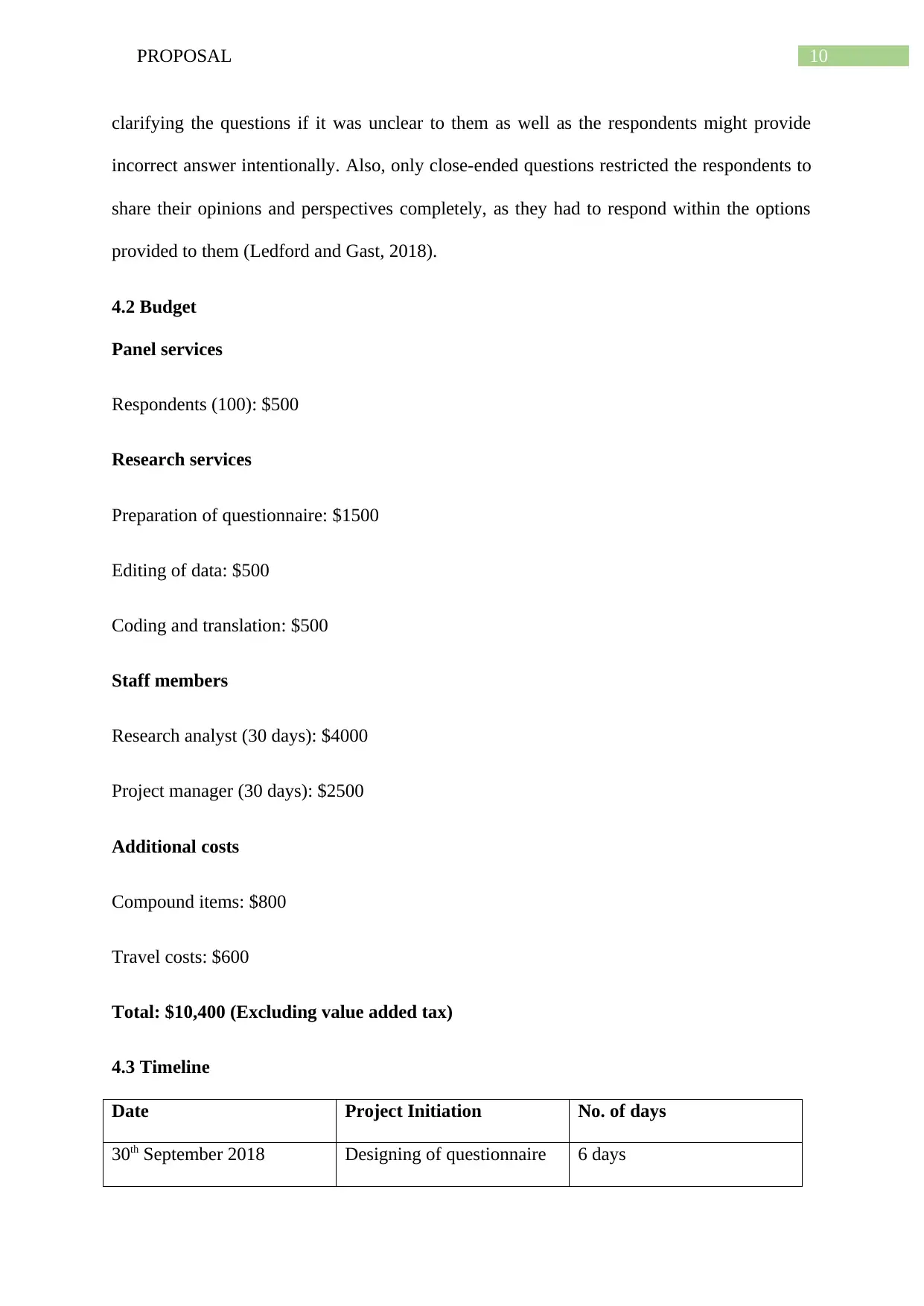
10PROPOSAL
clarifying the questions if it was unclear to them as well as the respondents might provide
incorrect answer intentionally. Also, only close-ended questions restricted the respondents to
share their opinions and perspectives completely, as they had to respond within the options
provided to them (Ledford and Gast, 2018).
4.2 Budget
Panel services
Respondents (100): $500
Research services
Preparation of questionnaire: $1500
Editing of data: $500
Coding and translation: $500
Staff members
Research analyst (30 days): $4000
Project manager (30 days): $2500
Additional costs
Compound items: $800
Travel costs: $600
Total: $10,400 (Excluding value added tax)
4.3 Timeline
Date Project Initiation No. of days
30th September 2018 Designing of questionnaire 6 days
clarifying the questions if it was unclear to them as well as the respondents might provide
incorrect answer intentionally. Also, only close-ended questions restricted the respondents to
share their opinions and perspectives completely, as they had to respond within the options
provided to them (Ledford and Gast, 2018).
4.2 Budget
Panel services
Respondents (100): $500
Research services
Preparation of questionnaire: $1500
Editing of data: $500
Coding and translation: $500
Staff members
Research analyst (30 days): $4000
Project manager (30 days): $2500
Additional costs
Compound items: $800
Travel costs: $600
Total: $10,400 (Excluding value added tax)
4.3 Timeline
Date Project Initiation No. of days
30th September 2018 Designing of questionnaire 6 days
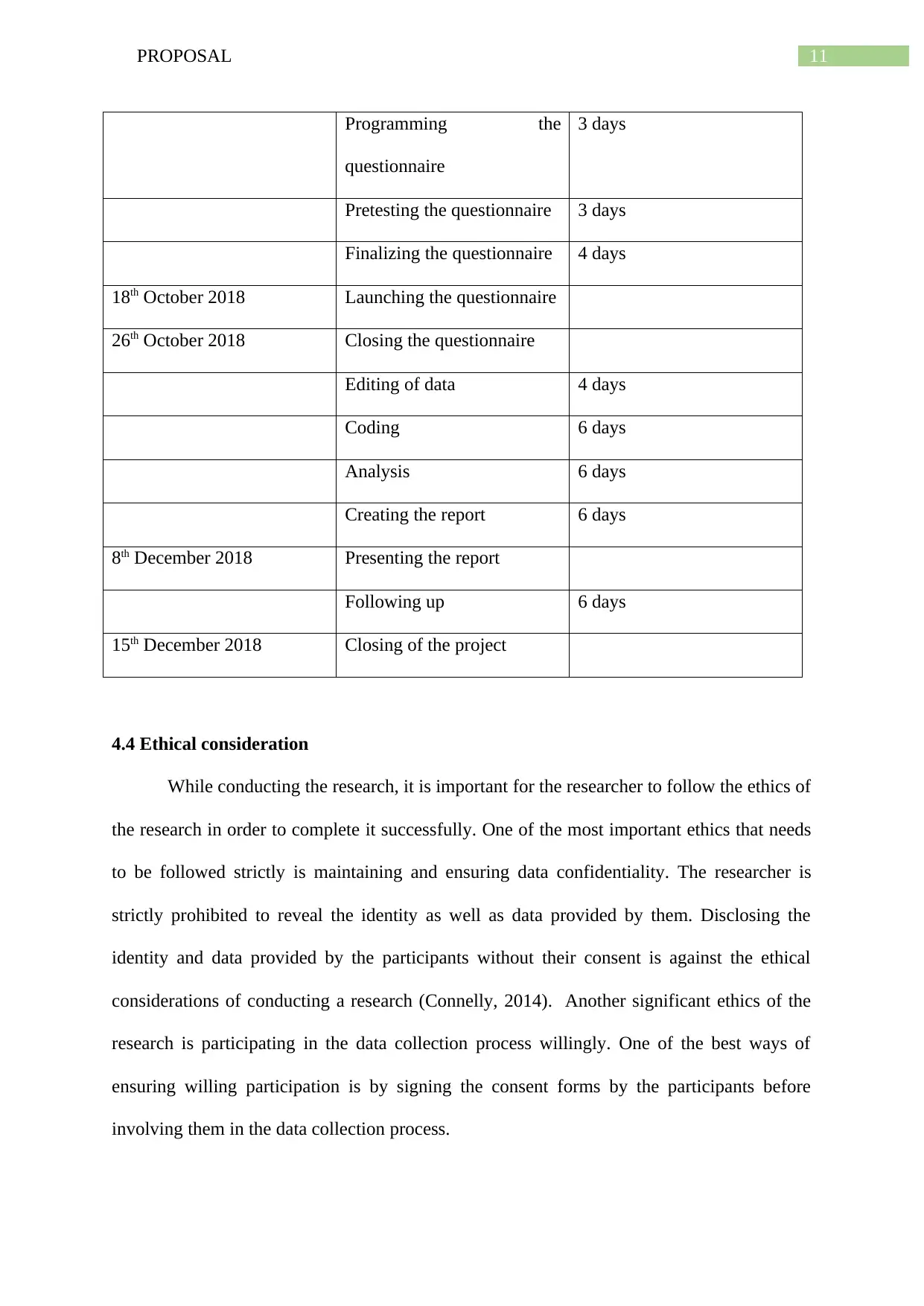
11PROPOSAL
Programming the
questionnaire
3 days
Pretesting the questionnaire 3 days
Finalizing the questionnaire 4 days
18th October 2018 Launching the questionnaire
26th October 2018 Closing the questionnaire
Editing of data 4 days
Coding 6 days
Analysis 6 days
Creating the report 6 days
8th December 2018 Presenting the report
Following up 6 days
15th December 2018 Closing of the project
4.4 Ethical consideration
While conducting the research, it is important for the researcher to follow the ethics of
the research in order to complete it successfully. One of the most important ethics that needs
to be followed strictly is maintaining and ensuring data confidentiality. The researcher is
strictly prohibited to reveal the identity as well as data provided by them. Disclosing the
identity and data provided by the participants without their consent is against the ethical
considerations of conducting a research (Connelly, 2014). Another significant ethics of the
research is participating in the data collection process willingly. One of the best ways of
ensuring willing participation is by signing the consent forms by the participants before
involving them in the data collection process.
Programming the
questionnaire
3 days
Pretesting the questionnaire 3 days
Finalizing the questionnaire 4 days
18th October 2018 Launching the questionnaire
26th October 2018 Closing the questionnaire
Editing of data 4 days
Coding 6 days
Analysis 6 days
Creating the report 6 days
8th December 2018 Presenting the report
Following up 6 days
15th December 2018 Closing of the project
4.4 Ethical consideration
While conducting the research, it is important for the researcher to follow the ethics of
the research in order to complete it successfully. One of the most important ethics that needs
to be followed strictly is maintaining and ensuring data confidentiality. The researcher is
strictly prohibited to reveal the identity as well as data provided by them. Disclosing the
identity and data provided by the participants without their consent is against the ethical
considerations of conducting a research (Connelly, 2014). Another significant ethics of the
research is participating in the data collection process willingly. One of the best ways of
ensuring willing participation is by signing the consent forms by the participants before
involving them in the data collection process.
⊘ This is a preview!⊘
Do you want full access?
Subscribe today to unlock all pages.

Trusted by 1+ million students worldwide
1 out of 15
Related Documents
Your All-in-One AI-Powered Toolkit for Academic Success.
+13062052269
info@desklib.com
Available 24*7 on WhatsApp / Email
![[object Object]](/_next/static/media/star-bottom.7253800d.svg)
Unlock your academic potential
Copyright © 2020–2025 A2Z Services. All Rights Reserved. Developed and managed by ZUCOL.




